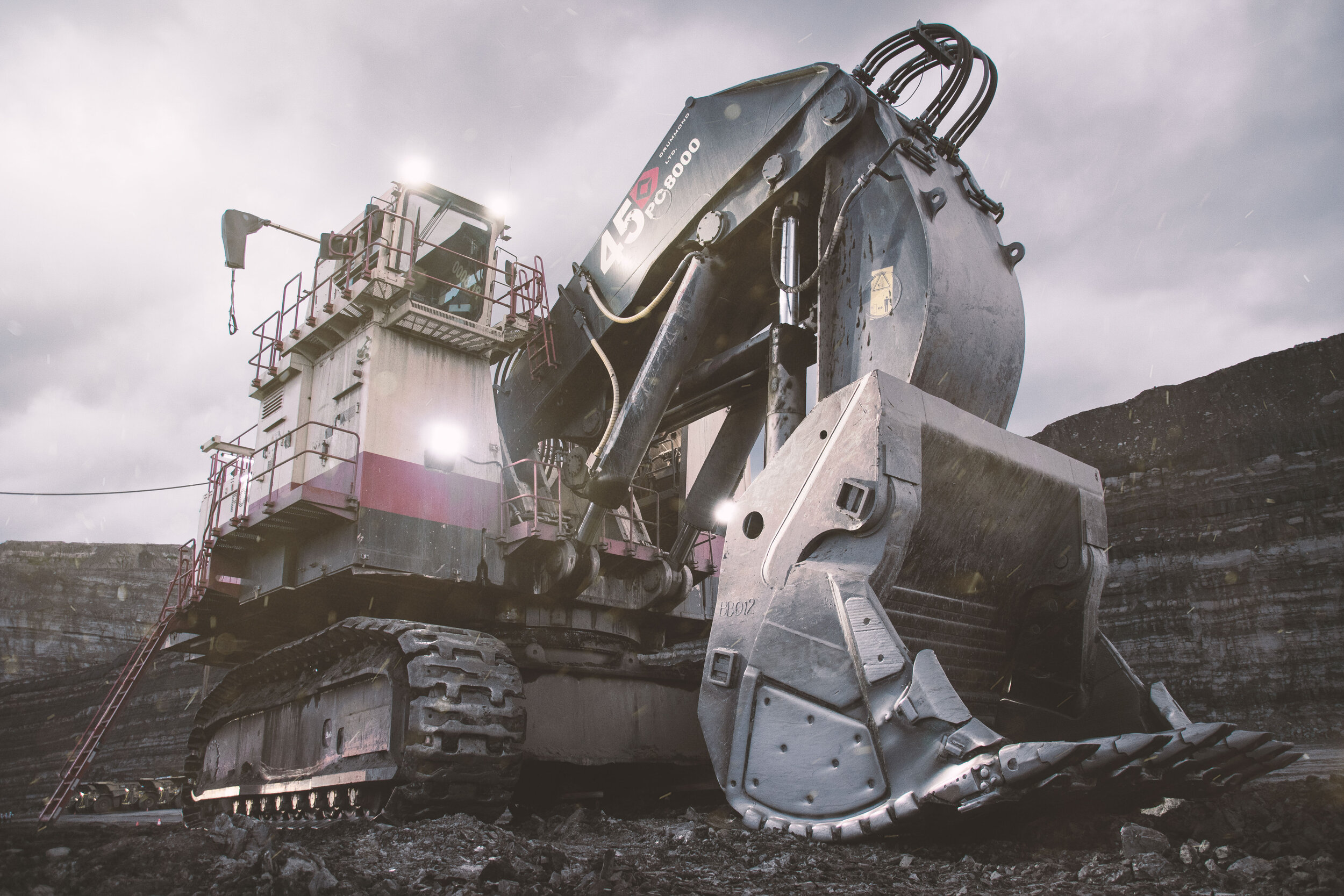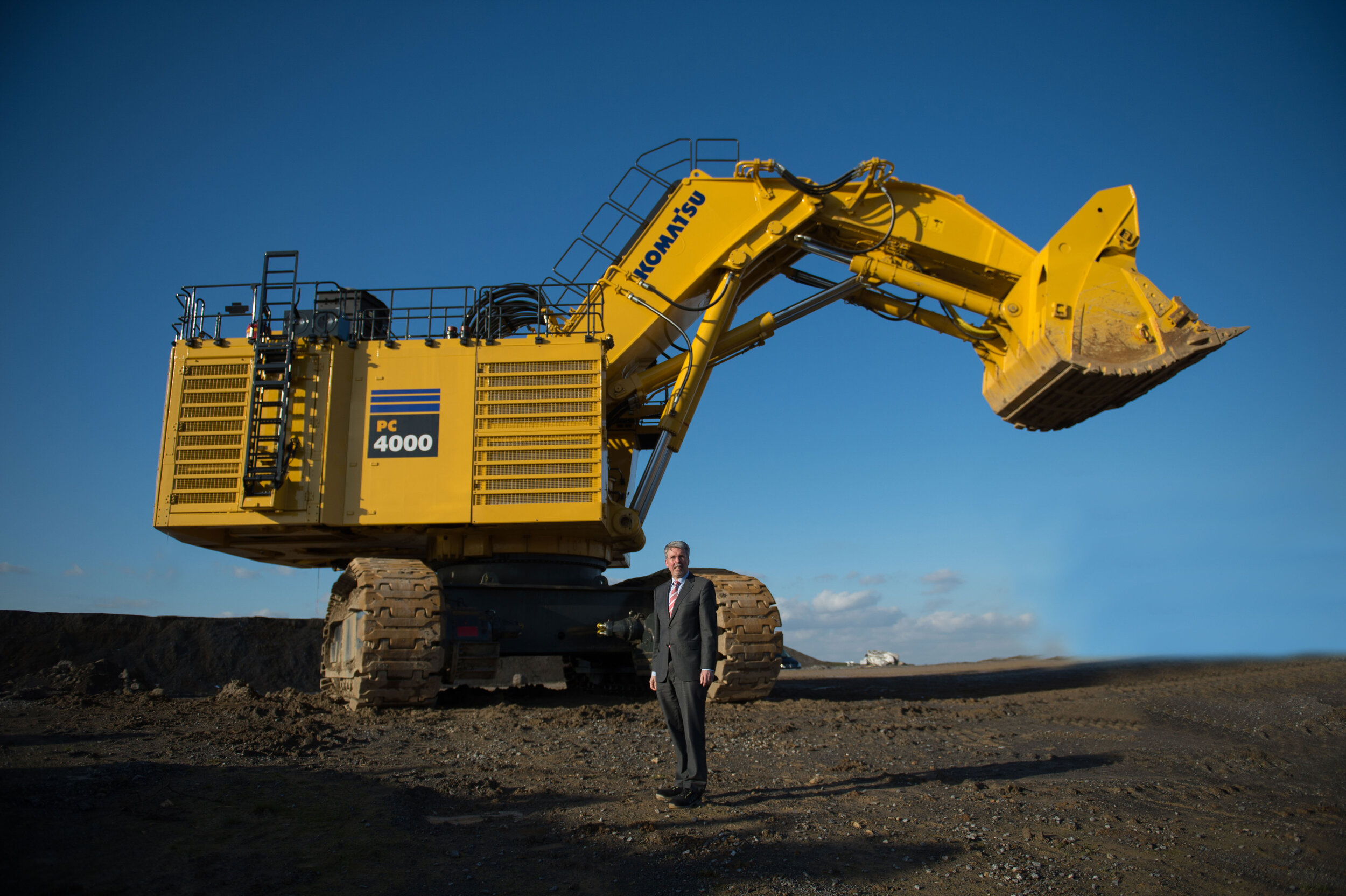Extraordinary Excavators
Komatsu Mining from Benrath is one of the world market leaders in the field of machines for the mining industry.
When one of the products manufactured at the Komatsu plant in Düsseldorf is completed, unusual activities start to happen in the district of Benrath. The excavators made by Komatsu are so huge, that they can only be transported in parts. 18 low loaders, carrying tons of weight, usually leave the factory grounds at Forststraße at night and, moving at a steady pace for about 20 minutes, reach the Reisholz river port. There the heavy goods are loaded onto a vessel. Along the river Rhine the journey initially leads towards the international ports of Rotterdam or Antwerp, and from there eventually across the world.
“We have all the core skills, that are necessary for the production of hydraulic excavators, on-site.”
he reason for this is that the Düsseldorf-based mining division of the excavator manufacturer Komatsu is entirely aimed at international trade. “We actually have no customers in Germany,” states Ralf Petzold, chairman of the board. Yet the excavator manufacturer in Benrath is one of the global market leaders within the mining industry. The high-performance machinery can be found in mines across the continents. The development and manufacture takes place at the plant in Forststraße - and also logistic, maintenance, services and spare parts are being handled at Komatsu’s headquarters in Düsseldorf. “We have all the core skills, that are necessary for the production of hydraulic excavators, on-site,” explains Petzold.
The plant location in Benrath has always been a place of innovation. The first ever entirely hydraulic excavator was manufactured here at Forststraße in 1954. In 1986 the predecessor company, Mannesmann-Demag, was the first manufacturer worldwide to build an ultra-large hydraulic excavator weighing about 500 tons. When Mannesmann-Demag became a mobile phone provider in 1996, it was joined by the Japanese company Komatsu, a leading manufacturer of construction equipment, which eventually took over the business a couple of years later. Its Japanese parent company produces the entire range of machinery and vehicles required for all applications in the construction and mining industry.
PC8000
• Can be used with its bucket to lift up to 90 tons of rock.
• The excavator operator sits eight meters above the ground.
• The bucket, with 42 cubic metres, has the size of a one-room flat.
Komatsu in Düsseldorf is still producing some of the world’s biggest and most modern excavators. The company offers five different types to its customers. The biggest excavator, the PC 8000, has an operating weight of 760 tons. Two engines supply a power of 1500 kW each. The PC 8000 can move up to 90 tons of rubble. The driver is actually seated 8 metres above ground. And with its capacity of 42 cubic metres, the actual bucket has a size of a one bedroom flat.
It is easy to continue with the list of superlatives, but it is equally as interesting to take a look at the different skills, which the 800-strong workforce contributes to the company. “We are specialists in the processing of specialty steel,” explains Ralf Petzold. In order for the excavator bucket to withstand the use on extremely hard rock over a period of time, it is necessary to use special welding and tempering procedures. “The highly skilled welders that we require we train ourselves in order to guarantee a superior quality,” explains the chairman of the board. Moreover, most of the electrical assembly for the highly specialised machines takes place in Benrath, too. “Düsseldorf and its catchment area stands out as a location where we can recruit expert personnel,” claims Petzold, “it is, however, becoming increasingly difficult.” This is one of the reasons Komatsu works closely together with schools in order to inspire students to enter one of these professions. There are about 40 apprentices working in the company’s training workshops, studying to become electricians and technical product designers as well as industrial-, cutting- or construction mechanics.
Impressive size comparison: Ralf Petzold, CEO, next to a PC400.
In addition, there is a team of about 80 engineers who are working on new ideas with regards to hydraulic excavators, as nowadays the use of even the goliath of excavators in mining requires more than just sheer power. Although the excavators’ looks haven’t changed much, it is on the inside where the giants have been changing into high tech machines, densely filled with the latest technology. Digitalisation is playing an increasingly important role in the mining industry. Nowadays, the operator can read with the supplementary system on the digital display how much bulk is already inside the bucket. A number of sensors transmit the excavator’s data to the service team in Düsseldorf via satellite. This way it is easier to supervise the state of the machine and to reduce down-time of the equipment. Despite the extreme wear and to some extent extreme climate conditions, the machines reach a working life of about 15 years. Some Komatsu excavators have even been around for more than 30 years. A sign for quality products.
E-powered driving systems are on the rise in the mining industry, too. Petzold explains that the reduction of emissions is a matter of importance for mining companies. In the case of the giant excavators electric engines actually meet the unique power requirements. “The bigger the machines get, the more we see diesel engines being replaced by e-power,” says Petzold.
The developers should always be some years ahead of their clients, Petzold states. He adds: “Developments in technology are constantly taking place.” The automation of routine processes, for example, is aimed to relieve the pressure on excavator operators on a daily basis. Komatsu’s idea of autonomous vehicles rolling through mines has already been adopted. In the future, the trucks weighing several tons, which drive the material in the mine from the excavator to the next processing stage, could be entirely computer-operated. The development department in Düsseldorf-Benrath is already working on the digitalisation of the next generation of excavators to make their use even safer and more effective in the future. •
Komatsu Germany
Forststraße 29
40597 Düsseldorf
Germany
Words: Rainer Kurlemann
Pictures: PR





